Brown is a convenient color to have for a snake. It’s dull and doesn’t attract much attention, which, in turn, lets the snake camouflage itself to either hide from predators or wait for prey. On the other hand, while white is a noticeable color, it surprisingly meshes well with the surroundings. Paired together, brown and white snakes know how to hide them.
Today we’ll be talking about these brown and white snakes. We’ll discuss the common 20 brown and white snakes and then list the rest. So, here we go:
20 Brown and White Snakes
1) Common Krait
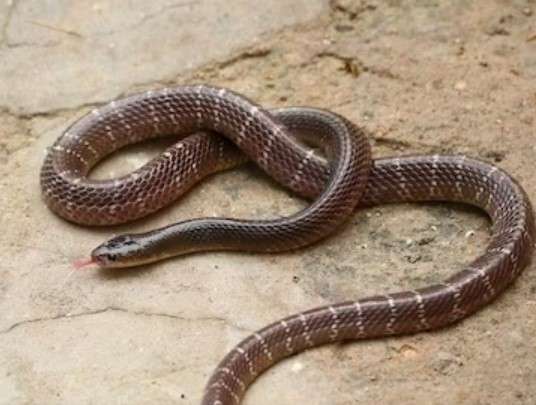
We’ll be starting off the list of brown and white snakes with the Common Krait. It is a highly venomous snake and one of the Big Four of India, i.e., the four venomous snakes that cause the highest death in the country. The venom of this snake is very potent and contains powerful neurotoxins.
The common krait is a fairly large and slender snake with dark brown skin and white stripes around the body. The head is completely brown and doesn’t have any stripes. The front of the snake is also stripe-less and uniformly white.
- Common Name: Bengal Krait
- Scientific name: Bungarus caeruleus
- Size: 2 ft 11 in – 5 ft 9 in
- Location: India, Sri Lanka, Bangladesh, Afghanistan, Nepal
2) California Kingsnake
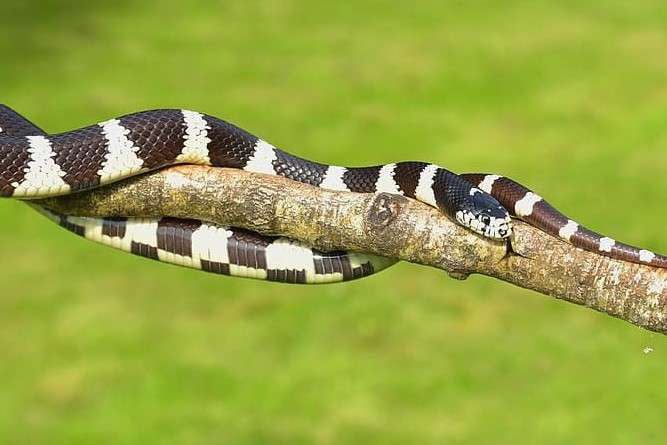
California Kingsnake is a nonvenomous snake species very popular as a pet.
The species has several color variants, which is another reason for it being very popular among reptile breeders. One of the color variants is brown as a background color with white stripes around the snake.
There has also been a specimen found in San Diego country of the USA, which has a brown body with a single white stripe running parallel with the length.
- Scientific name: Lampropeltis californiae
- Size: 76 – 107 centimeters
- Location: Western United States, northern Mexico
3) Bandy-Bandy
Bandy-Bandy is a venomous snake species endemic to Australia. The venom of this snake is potentially lethal to humans as it carries dangerous neurotoxins.
The snake also has a special condition where the toxins in its venom change with time as a way to side-step its prey, gaining immunity from the venom.
The bandy-bandy snake has a smooth and glossy body. It has dark brown as a background color with white stripes around the body. It has small eyes with yellow irises and black, round pupils.
- Common Name: Hoop Snake
- Scientific name: Vermicella annulata
- Size: 50 – 60 centimeters (20 – 24 inches)
- Location: East coast of Australia
4) Indian Wolf Snake

Indian Wolf Snake is a native of the Indian subcontinent. The snake is average-sized but girthy and closely resembles its Indian colleague, the Common Krait. The Indian wolf snake is nonvenomous, but the common krait is venomous, and the harmless snake mimics the latter in the form of Batesian Mimicry.
The Indian wolf snake has several color variations, including dark brown with pale yellow patterns. Another color scheme of this species is brown skin with white stripes on it. The ventral side is paler and lacks any markings.
- Scientific name: Lycodon aulicus
- Size: 71 centimeters
- Location: India, Sri Lanka, Pakistan
5) Corn Snake
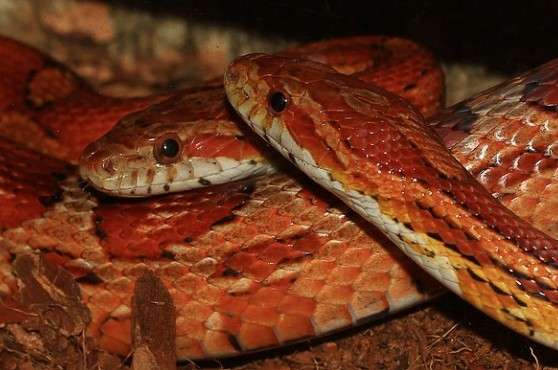
Corn Snake is a snake species native to the United States. This nonvenomous snake is often mistaken for the Eastern Copperhead snake, which is venomous and resembles the former.
Corn Snake has multiple bright colors to show off. The colors include a vibrant orange, yellow, and brown on the dorsal side. The ventral side is white with block-like black patterns on it. In another morph of the snake, the ventral side is uniformly white.
- Common Name: American Corn Snake
- Scientific name: Pantherophis guttatus
- Size: 61 – 182 centimeters
- Location: Southeastern United States
6) Desert Striped Whipsnake
The Desert Striped Whipsnake is an average-sized and slender snake residing in the grasslands of the USA and Mexico. The nonvenomous snake is very fast in its movement and alert to its surroundings. It also feeds on venomous rattlesnakes.
The body of the desert-striped whipsnake ranges from dark brown to muddy gray. It has a thin stripe of white running along the length of the body. In some specimens, the eponymous stripe is cream-colored. The belly side is completely white or cream-colored.
- Scientific name: Masticophis taeniatus
- Size: 76 – 183 centimeters (30 – 72 inches)
- Location: Western United States, northern Mexico
7) Sharp-Tailed Snake
Sharp-Tailed Snake is a species of nonvenomous snake that has a distinct sharp spine at its tail, hence the name. The spine is the protruding tip of the last vertebrae of the snake. It’s not harmful or dangerous but rather used to keep the food still as the snake feeds.
The back side of the sharp-tailed snake is colorful with orange and brown. There have also been some specimens with pink and peachy-orange skin. The front of the snake is white, with separate black bars running across the length of the body.
- Common Name: Sharptail Snake, Brown Snake, Gentle Brown Snake, Oregon Worm Snake, Pacific Brown snake, Pacific Ground Snake, and Purple-Tailed Snake
- Scientific name: Contia tenuis
- Size: 30 – 46 centimeters (12 – 18 inches)
- Location: Western United States, British Columbia of Canada
8) Ball Python

The Ball Python gets its name from the way it tends to curl into a ball when stressed or threatened. It’s a nonvenomous constrictor snake which is also the smallest of the African pythons. Ball pythons are very popular as pets.
The ball python has various color morphs that are frequently used in breeding by reptile breeders. One of the color morphs of this snake includes brown, gold, and white as the primary colors.
The back of the snake is brown with golden-yellow patterns and occasional white markings. The front is completely white without any pattern.
- Common Name: Royal Python
- Scientific name: Python regius
- Size: 6 feet
- Location: Senegal, Mali, Guinea-Bissau, Guinea, Sierra Leone, Liberia, Ivory Coast, Ghana, Benin, Nigeria through Cameroon, Chad, the Central African Republic, Sudan, Uganda
9) Eastern Ribbon Snake
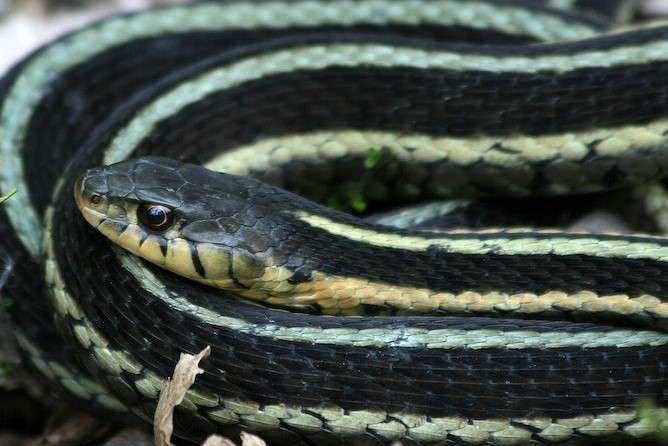
We have another nonvenomous snake on our list of brown and white snakes. The Eastern Ribbon Snake is a species of small and thin snake. Its slender body is the reason for its name. It is also one of the snake species where some females are known to eat their young.
The eastern ribbon snake does have a few colors on its body. The back of the body has dark brown, yellow, and pale yellow or white in narrow parallel stripes across the body. The front side is completely white. The mouth of the snake is also white, as well as the borders around its eyes.
- Common Name: Common Ribbon Snake
- Scientific name: Thamnophis sauritus sauritus
- Size: 18 – 86 centimeters (7 – 34 inches)
- Location: Southeastern United States
10) White-bellied rat Snake
The last entry on this brown-and-white snake list is the White-Bellied Rat Snake. While a nonvenomous snake, it has a habit of hissing when under threat or frightened. It also is known for getting still and keeping its neck erect in threatening situations.
True to its name, the white-bellied snake has a pure, uniform white on the underside of its body. The back of the body is brown with minute black markings. Its eyes are big and dark brown with black, round irises.
- Common Name: Brown Rat Snake
- Scientific name: Ptyas fusca
- Size: 6.6 – 9.8 feet
- Location: Indonesia, Brunei, Malaysia, Thailand, Singapore
11) Pacific Gopher Snake
Another alluring brown and white snake is the Pacific Gopher Snake. They mostly prefer dry habitats, from meadows to dense forests.
These snakes are primarily brownish-yellow in color with white or gray markings.
These snakes are non-venomous and mimic rattlesnakes by producing a loud hissing sound when they feel threatened. You can find this snake species on the West Coast of North America.
- Common Name: Pacific gopher snake, coast gopher snake, western gopher snake
- Scientific name: Pituophis catenifer catenifer
- Size: 36-84 in (91–213 cm)
- Location: West Coast of North America
12) Piebald Ball Python
Piebald are the morphs of ball pythons (Python regius) produced by genetic mutation. These morphs are paper white in color with random splotches of different colors like black, brown, yellow, orange, etc.
These non-venomous snakes are commonly found in West Africa, inhabiting grasslands, shrublands, and open forests.
They exhibit sexual dimorphism, like females being heavier and longer than males. They primarily prefer rodents, birds, and some other small mammals, like all other pythons.
- Common Name: Piebald Ball Python
- Scientific name: Python regius
- Size: 3 to 5 feet
- Location: West Africa
13) North American Racer (Juvenile)
These snake species are endemic to North and Central America. Their juvenile forms are light tan or white in color with dark black or brown blotches. but as they grew, these patterns changed.
They are medium-sized, with an average body length of 50 to 152 cm. As their name indicates, they can crawl very fast, around 6.5 km per hour, just like a human’s brisk walk.
Non-venomous but can bite with their sharp and recurved teeth that can even cause bleeding.
- Common Name: Eastern racer, North American racer
- Scientific name: Coluber constrictor
- Size: 50 to 152 cm (20 to 60 in)
- Location: North and Central America
14) Common Garter Snake
https://www.pinterest.com/pin/31947478597633531/
The next snake we have on our list of brown and white snakes is the common garter snake. These diurnal snakes are commonly found in n, from Mexico to Canada.
They are not venomous, but their saliva contains mild toxins that are found in smaller animals. They are medium-sized, with an average length of up to 4 feet.
Ovoviviparous, polygyandrous, and form mating balls in which one or two females with eight or ten males are present. They are blackish brown in color with different color stripes like yellow, gold, brown, white, etc.
- Common Name: Common Garter Snake
- Scientific name: Thamnophis sirtalis
- Size: up to 4 ft (1.2 m)
- Location: North America
15) Gray Rat Snake
Gray rat snake, central rat snake, chicken snake, midland rat snake, or pilot black snake are some of the common names of Pantherophis spiloides.
They are grayish-white in color with dark brown or black blotches, which they retained from their juvenile stage. One can find these snakes in North America.
When they feel threatened, they release foul-smelling contents from their cloaca. These non-venomous snakes sometimes mimic rattlesnakes.
- Common Name: Gray rat snake, central rat snake, chicken snake, midland rat snake, or pilot black snake
- Scientific name: Pantherophis spiloides
- Size: 99–183 cm (3.25–6.00 ft)
- Location: North America
16) Keeled Rat Snake
It is one of the largest snakes in the colubrid family, which includes more than half of the living snake species. These diurnal species mostly feed on rats and other small animals.
They are dark brown or black in color with yellow or white spots and have a characteristically keeled body shape. maximum, they can attain a size of up to 4 m. Males of this species are mostly larger than females.
- Common Name: Keeled Rat Snake
- Scientific name: Ptyas carinata
- Size: 1.21 to 2.75 m (4 ft 0 in to 9 ft 0 in)
- Location: Indonesia, Myanmar, Malaysia, Thailand, Philippines, Cambodia, India, Vietnam, and Singapore
17) Indian Egg Eater
Also known as Westermann’s snake due to their discovery by Geraldus Frederick Westermann (Dutch Zoologist). They have bluish-white spots on their posterior surface with a glossy brown or black hue.
As their name suggests, they feed on bird eggs and their enamel-capped cervical vertebrae are projected in the esophagus, which helps them crack the eggshells.
- Common Name: Indian egg-eating snake or Indian egg-eater
- Scientific name: Elachistodon westermanni
- Size: up to 78 cm (31 inches)
- Location: Bangladesh, India, and Nepal
18) Western rat snake
The Pantherophis obsoletus, or Western rat snake, is the most common brown and white snake found in Central North America. They are the longest snakes in North America, with an average size of 3 feet 6 inches to 6 feet.
Their juvenile stages have patterns of brown blotches on a grayish-white background. They are non-venomous and kill their prey by constricting them.
- Common Name: Western rat snake, black rat snake, pilot black snake, or black snake
- Scientific name: Pantherophis obsoletus
- Size: 106.5–183 cm (3 ft 6 in – 6 ft 0 in)
- Location: North America
19) Red-Sided Garter Snake
Females of Red-sided Garter snakes tend to be larger than males. one can find this medium-sized snake in the Northern United States and Southern Canada.
As their name indicates, they have a row of red spots on their dark brownish body and have yellowish-white stripes all along their body.
It has a mild venom in its saliva that can subdue its prey, such as frogs, mice, and worms.
- Common Name: Red-sided garter snake
- Scientific name: Thamnophis sirtalis parietalis
- Size: 12 to 24 inches
- Location: Northern United States and southern Canada
20) Many-Banded Krait (Venomous)
https://www.pinterest.com/pin/122723158586750812/
Many banded kraits are very dangerous and venomous krait species that are glossy black or brown in color with white crossbands.
The venom of many banded kraits is very dangerous because it contains pre- or post-synaptic neurotoxins.
This medium-sized snake can grow up to 1 to 1.5 m. They primarily feed on fish, unlike other krait species.
- Common Name: Many-banded krait, Taiwanese krait, or Chinese krait
- Scientific name: Bungarus multicinctus
- Size: 1 to 1.5 m (3.5 to 5 ft)
- Location: Central and southern China and Southeast Asia
(*) denotes venomous.
Conclusion
These are the brown and white snakes in the world. Of course, there are still some that are yet to be discovered or some unique color morph of a species.
If we missed any of them, let us know. And while you’re at it, don’t forget to mention your thoughts on this piece. You can also check out some of our similar articles on snakes and other animals.
Frequently Asked Questions:
Q1) What kind of snake is brown and white?
Ans. We included 20 brown and white snake species in this article. Some of the brown and white snakes are common kraits, California kingsnakes, Indian wolf snakes, and sharp-tailed snakes.
Q2) Are brown-striped snakes venomous?
Ans. Most brown-striped snakes are non-venomous.
Q3) Which brown snake is venomous?
Ans. Common krait, Bandy-Bandy, and many banded kraits are some of the brown snakes that are venomous.
Q4) What snake is brown with a white belly?
Ans. Western rat snake, white-bellied rat snake, Eastern ribbon snake, ball python, and sharp-tailed snake are some of the brown with white belly snake species.
Q5) How can you tell if a snake is venomous?
Ans. Head shape, eye shape, body coloration, rattle, and their habitats are some of the characteristics and features of venomous snakes.
Q6) Are rat snakes venomous?
Ans. Rat snakes are non-venomous snake species.
Q7) What baby snake is brown?
Ans. Eastern rat snakes, garter snakes, king snakes, and Copperheads are some of the snake species whose babies are brown in color.
Also Read:
Red Snake with Blue Patterns– What Could it Be?
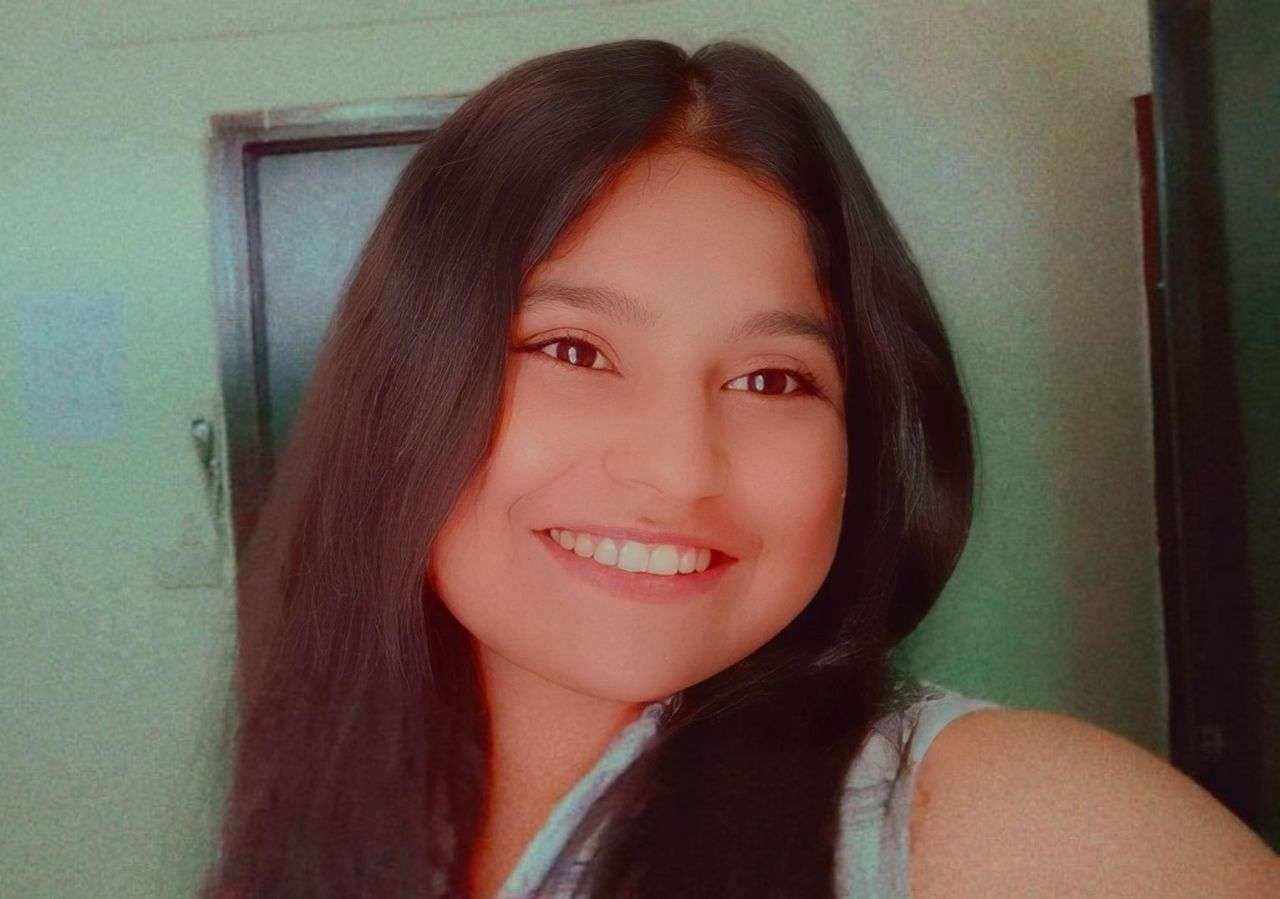
Being a zoology student I’m always been fascinated toward animals especially insects. I love to do research and learn about different animals. As a writer I want to share my thoughts about nature through my articles. Apart from this you can find me exploring the new places and voice notes.

